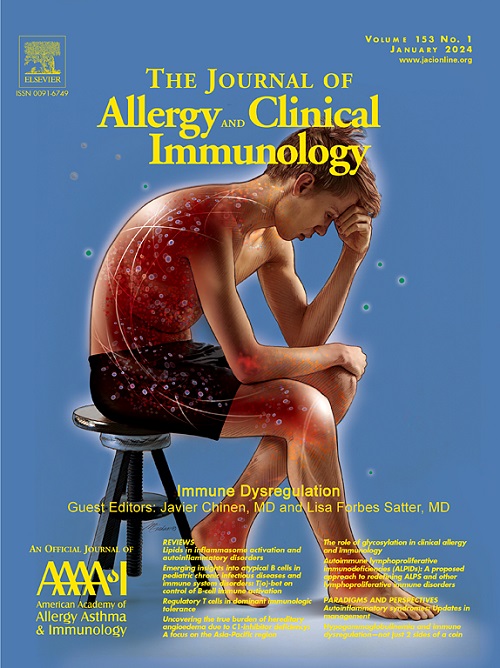Cendakimab(抗il -13)可改善嗜酸性食管炎患者食管基因表达。
IF 11.2
1区 医学
Q1 ALLERGY
引用次数: 0
摘要
背景:il -13被认为是嗜酸性粒细胞性食管炎(EoE)发病机制的关键因素,部分原因是在HEROES 2期试验中发现,cendakimab(一种人源化单克隆抗il -13抗体)可显著改善食管嗜酸性粒细胞、内镜严重程度、组织学分级和分期以及临床医生对严重程度的评估。目的:在HEROES 2期临床试验(NCT02098473)中,我们旨在确定cendakimab给药对食管基因表达的影响。方法在基线(第0周)和16周注射(第16周)cendakimab (180 mg或360 mg)或安慰剂后收集的活检中定量分析see - e相关转录本。经cendakimab处理后,基因表现出差异表达。比较组织学和内镜下反应者和无反应者治疗前后的食管基因表达。此外,我们评估了食管基因表达是否与组织学和内镜参数相关。结果与安慰剂相比,cendakimab(两种剂量)逆转了参与EoE发病的主要基因和分子通路的基因表达谱。这些变化包括参与IL-13信号传导(如CCL26)、肥大细胞增生(如CPA3、TPSB2/TPSAB1)、上皮分化(如DSG1)和重塑(如POSTN)的基因。转录变化与组织学和内窥镜观察相关。未达到组织学缓解的患者仍然表现出治疗后转录物表达的改善,尽管与未达到组织学缓解的患者相比,达到组织学缓解的患者在治疗后基因亚群表达方面表现出更大的改善。内镜下反应者和无反应者治疗后表达均有改善。结论cendakimab治疗使EoE患者异常的食管基因表达正常化,并且转录物的变化与组织学和内镜下的改善相关。cendakimab即使在内镜下无应答者中也能纠正食管转录物表达,这一发现表明IL-13途径在大多数患者中驱动EoE发病机制。这些集体发现来自一项多位点、双盲、安慰剂对照试验,增加了IL-13驱动EoE发病机制的分子证据。本文章由计算机程序翻译,如有差异,请以英文原文为准。
Cendakimab (Anti-IL-13) administration improves esophageal gene expression in eosinophilic esophagitis.
BACKGROUND
IL-13 has been implicated as a key contributor to the pathogenesis of eosinophilic esophagitis (EoE) based in part on the finding that cendakimab (a humanized monoclonal anti-IL-13 antibody) significantly improved esophageal eosinophils, endoscopic severity, histology grade and stage, and clinician's assessment of severity in the HEROES phase 2 trial.
OBJECTIVE
We aimed to determine how cendakimab administration impacted esophageal gene expression in the HEROES phase 2 trial (NCT02098473).
METHODS
EoE-related transcripts were quantified in biopsies collected at baseline (week 0) and after 16 weekly injections (week 16) of cendakimab (180 mg or 360 mg) or placebo. Genes exhibiting differential expression after cendakimab treatment were identified. Esophageal gene expression pre- and post-treatment in histologic and endoscopic responders and non-responders was compared. Additionally, we assessed whether esophageal gene expression correlated with histologic and endoscopic parameters.
RESULTS
Compared with placebo, cendakimab (at both doses) reversed the gene expression profiles of cardinal genes and molecular pathways involved in EoE pathogenesis. These changes included genes involved in IL-13 signaling (eg, CCL26), mastocytosis (eg, CPA3, TPSB2/TPSAB1), epithelial differentiation (eg, DSG1), and remodeling (eg, POSTN). Transcript changes correlated with histologic and endoscopic observations. Patients who did not achieve histologic remission still demonstrated improved post-treatment transcript expression, although patients who achieved histologic remission exhibited greater improvement in post-treatment expression in a subset of genes than did patients who did not achieve histologic remission. Both endoscopic responders and non-responders exhibited improvement in post-treatment expression.
CONCLUSION
Cendakimab treatment normalizes the aberrant esophageal gene expression seen in patients with EoE, and the changes in transcripts correlate with histologic and endoscopic improvements. The finding that cendakimab corrects esophageal transcript expression even in endoscopic non-responders suggests that the IL-13 pathway is driving EoE pathogenesis in most patients. These collective findings, derived from a multisite, double-blinded, placebo-controlled trial, add molecular evidence that IL-13 drives EoE pathogenesis.
求助全文
通过发布文献求助,成功后即可免费获取论文全文。
去求助
来源期刊
CiteScore
25.90
自引率
7.70%
发文量
1302
审稿时长
38 days
期刊介绍:
The Journal of Allergy and Clinical Immunology is a prestigious publication that features groundbreaking research in the fields of Allergy, Asthma, and Immunology. This influential journal publishes high-impact research papers that explore various topics, including asthma, food allergy, allergic rhinitis, atopic dermatitis, primary immune deficiencies, occupational and environmental allergy, and other allergic and immunologic diseases. The articles not only report on clinical trials and mechanistic studies but also provide insights into novel therapies, underlying mechanisms, and important discoveries that contribute to our understanding of these diseases. By sharing this valuable information, the journal aims to enhance the diagnosis and management of patients in the future.

 求助内容:
求助内容: 应助结果提醒方式:
应助结果提醒方式:


